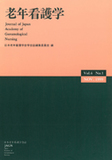Japanese
English
- 販売していません
- Abstract 文献概要
- 参考文献 Reference
本研究の目的は,大腿骨頸部骨折後の回復過程にある老人の対処行動の意味と行動に伴う意識変容を明らかにすることにあった.対象は,65〜91歳までの手術を受けた老人患者30名である.データは,retrospectiveな方法をとり,医師および看護婦の臨床記録より収集し,qualitative research methodsを用いて患者の言動を分析し,ラベル付け,カテゴリー化を行った.その結果,4つの対処様式とストレス反応が導き出された.結果は,以下のとおりである.
1)4つの対処様式を通して導き出されたストレス反応は,身体機能回復への可能性および自己像喪失の脅威であった.
2)4つの対処様式は,【自己同一の維持】【自己統制】【情報提供と情報獲得】【挑戦と自己統合】であった.
3)4つの対処様式は,環境と自己との関係において認知される脅威に対し,自己を維持し,保護し,安定させる目的で用いられていた.4つの対処様式は,その時その場で認知される脅威によって異なるが,自己概念の一貫性や恒常性,安定した構造を確保するための対処として用いられていた.対処行動の背後には,脅威による自己概念構造の力動的相互関連が想定された.
The purpose of this study was to identify the meaning of their coping behaviors in patients with hip fractures. The subjects were 30 elderly persons, aged 65 to 91, to have surgical treatment. The data were collected from doctors' and nurses' charts, using retrospective methods. These data (their words and behaviors) were analysed by the qualitative research methods. Ultimately, four coping modes and stressors were founded. The results are as follows :
1) Their stressors supposed by four coping modes were a threat to the loss of self-image before they fractured and a threat to have the possibility of functional recovery from hip fracture.
2) Four coping modes were 【preservation of self-identity】,【self-control】,【to offer information and to acquire information】,【challenge and self-integration】.
3) Four coping modes were used to preserve, to protect and to stabilize themselves for a recognized threat in the interaction of them with the environment. Coping modes were used according to own recognized threat and their circumstances. From the above results, dynamic interaction at the back of coping behaviors was supposed in the structure of self-conception.
Copyright © 1999, Japan Academy of Gerontological Nursing All rights reserved.


